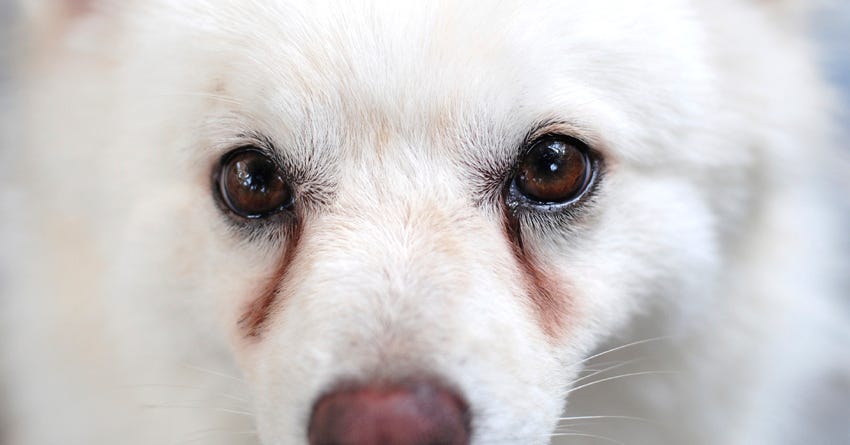Tear stains can be a frustrating concern for pet owners. Those unsightly reddish-brown streaks around your pet’s eyes can mar their otherwise adorable appearance. Tear stains aren’t just a cosmetic issue; they might also signal underlying health or environmental concerns. While all pets can experience tear stains, certain breeds like Poodles, Maltese, and Shih Tzus are more prone due to their facial structure or genetics. But fear not! With the right knowledge and tools, managing and preventing tear stains is entirely achievable.
What Are Tear Stains and What Causes Them?

Tear stains are discoloured marks, typically reddish or brown, that form beneath your pet’s eyes. They result from excessive tear production, which mixes with bacteria or yeast, leading to the stains’ characteristic colour. These stains are most noticeable in lighter-coated pets but can affect any breed.
What causes tear stains?
- Facial Anatomy: Pets with short noses or shallow eye sockets are more likely to have tear stains due to the structure of their tear ducts.
- Health Conditions: Tear stains can signal tear duct blockages, eye infections, or even allergies.
- Diet and Water Quality: High-mineral content in tap water or low-quality pet food can contribute to tear staining.
- Environmental Irritants: Dust, smoke, and other allergens may irritate your pet’s eyes, causing them to water excessively.
Understanding the root cause is the first step towards addressing tear stains effectively.
Solutions for Tear Stains
When it comes to removing tear stains, the right approach depends on identifying and addressing their cause. Fortunately, several solutions can help, with tear stain removers being a reliable go-to.
Using a Quality Tear Remover
Tear removers are specially designed products that clean and lighten discoloured areas beneath your pet’s eyes. Available in various forms—wipes, powders, sprays, and liquids—they cater to different needs and preferences.
When choosing a tear remover, it’s important to look for natural, hypoallergenic options that are free from harsh chemicals. These products are gentle on your pet’s sensitive eye area and reduce the risk of irritation.
Regular application of a tear remover can work wonders. Wipes are convenient for quick clean-ups, while powders can help keep the area dry and prevent yeast or bacteria buildup. Sprays and liquids are great for thorough cleaning, particularly for stubborn stains.
Most tear stain removers also contain antimicrobial ingredients to combat bacteria and yeast, which are primary contributors to staining. Some even include soothing agents like aloe vera to ensure your pet’s comfort during application.
Consistency is key. With regular use, you’ll not only see visible improvements in your pet’s appearance but also notice a reduction in tear stain recurrence.
Pro tip: Always follow the instructions on the product label and consult your vet if you’re unsure about which product is best for your pet.
By incorporating a high-quality tear remover into your pet’s grooming routine, you can tackle existing stains and prevent new ones from forming, keeping your furry friend’s face clean and bright.
Regular Grooming
- Keeping the area around your pet’s eyes clean and dry is essential. Use a soft, damp cloth or specialised wipes to remove debris and keep tears from accumulating.
- Grooming also prevents matting, which can trap moisture and exacerbate staining.
Dietary Adjustments
- Switching to purified or distilled water can minimise the minerals contributing to tear stains.
- Feed your pet high-quality, balanced food that supports their overall health and minimises allergens.
Veterinary Assistance
- If tear stains persist despite your efforts, it may be time to consult your vet. They can check for underlying issues like infections, blocked tear ducts, or allergies and recommend specific treatments.
Preventing Tear Stains in the Future

While managing existing stains is important, prevention is the ultimate goal. A proactive approach can keep those unsightly streaks at bay and ensure your pet stays comfortable and healthy.
Establish a Grooming Routine
Regularly cleaning the eye area with a pet-safe tear remover can prevent buildup before it becomes a problem.
Schedule professional grooming sessions if your pet has long hair around their eyes that might trap moisture.
Mind Their Diet and Water
Stick to high-quality pet food free from fillers and artificial additives that can contribute to excessive tearing.
Always provide fresh, filtered water to minimise mineral deposits.
Watch for Irritants
Keep your pet’s environment clean and free from dust, smoke, or other potential irritants.
If your pet is prone to allergies, consult your vet for solutions to manage their symptoms.
Check Regularly for Issues
Be vigilant about changes in your pet’s eyes or tear production. Early detection of potential problems can save your pet from discomfort and prevent stains from forming. You can ensure your pet enjoys a tear-stain-free life by staying consistent and attentive.
Conclusion
Tear stains may seem like a small issue, but addressing them can significantly improve your pet’s health and appearance. We’ve explored tear stains, their causes, and how to manage them effectively using solutions like tear stain removers. Preventative measures such as regular grooming, dietary adjustments, and minimising environmental irritants can go a long way in keeping tear stains at bay.
So, the next time you ask, “How do I get rid of tear stains on my dog?” remember that with the right care, your pet can stay happy, healthy, and picture-perfect!